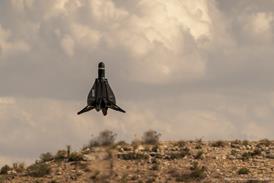Tim Furniss/LONDON
The US Air Force has authorised production of Boeing's first Evolved Expendable Launch Vehicle (EELV) Delta IV booster, which will launch a military Defence Space Communications System (DSCS) satellite in May 2002.
The Delta IV Medium model is capable of placing 4,210kg (9,270lb) into geostationary transfer orbit (GTO). Recent DSCS satellites have been launched on the Space Shuttle and Atlas boosters.
Boeing is developing five variants of the Delta IV, which would be capable of placing between 4,210kg and 13,130kg into GTO. The US Air Force awarded Boeing a $500 million contract to produce 19 of the first 28 EELVs, with Lockheed Martin's Atlas V to launch the rest.
Boeing has invested more than $500 million in developing the Delta IV range. Development of the smaller versions of the Delta IV, to replace Delta II and III models, was originally aimed at the low- Earth orbit (LEO) communications satellite market.
Boeing does not expect recovery in that market for at least three years, mainly because of the collapse of the Iridium satellite venture and the ensuing fall-out. Boeing was originally hoping for a 30-50% share of the LEO market.
The geostationary satellite launch market remains stable, with slight growth forecast to 2007. Boeing is aiming for at least 30% of that market.
The troubled Delta III is aiming for its third launch attempt on 23 August. The mission will carry a dummy satellite in the hope of raising customer confidence in the vehicle, which suffered failures on its first two launches. Further delays to the Delta III programme could make it obsolete earlier than expected, as the Delta IV will be ready by late 2001.
• A Boeing Delta II booster was launched from Cape Canaveral on 16 July carrying a Navstar global positioning system (GPS) navigation satellite into orbit for the US Air Force.
This was the 29th Delta II launch of a GPS satellite. A further 16 GPS launches are assigned to the vehicle. The operational GPS constellation comprises 28 spacecraft following the failure in orbit of a $65 million Lockheed Martin-built Navstar GPS satellite. The satellite, launched in 1989, had exceeded its predicted 7.5-year lifetime. The GPS system relies on an operational fleet of 24 satellites with in-orbit spares.
Source: Flight International























